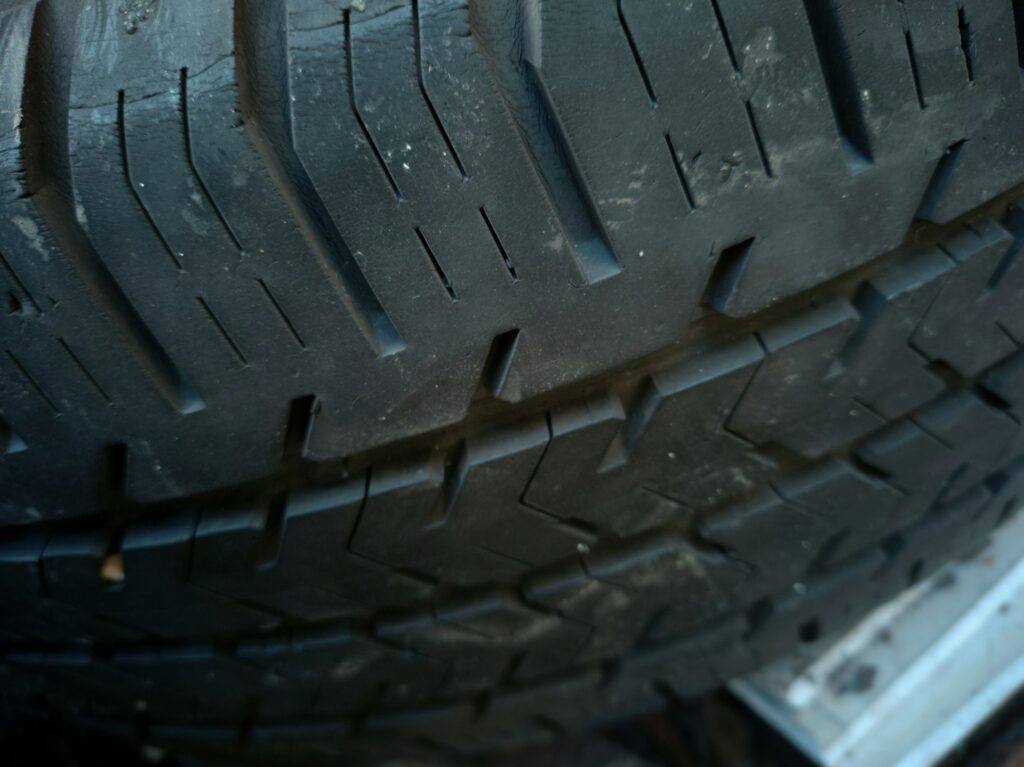Replacing your tires on time is one of many ways to prevent significant repairs or damage to your vehicle. Like carrying good car insurance, this is a solid money-saving maneuver that every driver should practice. Having the right tires will also help you stay safe on the road, preventing potential accidents you must protect your car against.
While considering money-saving measures, check your car insurance to ensure you have the best deal available. We offer the most affordable and reliable insurance plans in Illinois, ranging from the minimum required liability insurance to SR22-compliant coverage.
The Tread Is Too Low

a close up of a tire on a vehicle by Lallaoke is licensed with Unsplash License
The easiest way to know if you need new tires is to check the tread; if the tread depth is less than 2/32 inches, you must replace them. You can measure your tire tread by:
- Placing a penny in the tread. If you can see the top of Lincoln’s head, the tread is too shallow.
- Looking for the tread wear bars. If these horizontal bars in the tread are exposed, you need new tires.
- Using a tread depth tire gauge. Keeping this handy tool in the car will help you measure the exact depth of your tread periodically to see how fast your tires wear down and anticipate your next tire replacement in advance.
Driving on tires with low treads, a key indicator of thin rubber, is dangerous. Thin tires are prone to blowouts, which can cause you to lose control on the road. They also lose air more quickly, increasing your risk of low tire pressure, which diminishes fuel efficiency. Cars with low tread are also more likely to hydroplane or lose traction on snow and ice.
The Season Is Changing
If you’re using seasonal tires, such as winter tires, you should change them when the weather changes. Winter tires have a specific tread pattern designed for ice and snow. However, they result in poor efficiency, noisy operation, and subpar performance in warmer weather. If your winter tires still have ample tread, store them for use next year.
Your Tires Are Too Old
In Chicago, you may rely primarily on public transportation and use your car infrequently. However, even if you don’t drive often, you may need to replace your tires despite having an adequate tread depth. Most manufacturers design their tires to last only six to ten years because the average driver will wear down the tread long before these years have passed.
You can determine your tire’s age by looking at the Department of Transportation tire identification number on the sidewall. The last four digits of this number indicate the week and year of manufacture. If your tire is over 10 years old, you should replace it regardless of its condition.
You’re Replacing a Damaged Tire
Inspect your tires often and replace any with bulges, cracks, or other signs of damage.
Depending on the age and condition of your other tires, you may want to replace the whole set while replacing one. Tire stores often offer money-saving deals when you buy a complete set of tires, such as buy three get one free. Replacing all your tires at once will also keep you on the same schedule for tire rotations and alignments.
You Can Get a Great Price
If you have a place to store extra tires, the best time to buy new tires is when they’re on sale. Tire retailers often have great sales in spring and fall as they try to clear out their seasonal inventory for an influx of new products. The end of the year is another good time to look for tire sales.
Purchasing tires in advance also helps ensure you’re well-prepared when it’s time to swap out your aging ones. If you wait until a blowout, you’ll have to buy a new tire immediately, regardless of the price. Planning for the worst is a great way to save money.
Choosing the Right Tires
Consult your owner’s manual for details on the proper size and type of tire for your vehicle. Unless you purchased a used car with the wrong kind of tires, you’ll usually buy new ones that are a near match for the old ones. In Illinois, you may also want to consider winter tires for the cold weather months, as we can get a good amount of snow and ice.
As with many things, you get what you pay for when it comes to tires. Investing in higher-quality tires now usually pays off in better performance, gas mileage, and life span.
Making Your Tires Last
You can extend the life span of your new tires by diligently scheduling care and maintenance for them. This includes:
- Checking tire pressure: Check your tire pressure at least once a month or whenever the temperature changes by 10 degrees Fahrenheit. Air up your tires as needed.
- Rotating your tires: Have your tires rotated with every oil change or every 5,000 to 7,000 miles to help them wear evenly.
- Balancing and aligning your tires: Have your tires balanced and aligned every 7,000 miles or during your rotation. You should also balance your tires whenever you notice the steering wheel shaking.
With routine maintenance, you should get at least 50,000 miles out of your tires.
Properly Protecting Your Vehicle
Proper precautions are essential to keeping your vehicle safe. Maintaining your car insurance as diligently as you maintain your tires will help you offset significant expenses if you’re in an accident. Our American Auto Insurance team offers a wide range of coverage options. We’ll help you navigate the entire process, from comparing plans to securing a quote to signing up for your new coverage. We even offer SR22 certificates where required. Call us now to get started.

